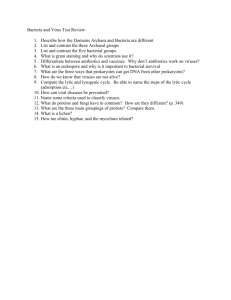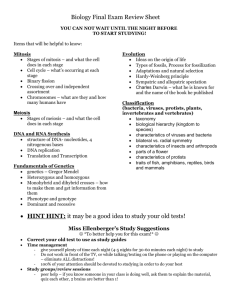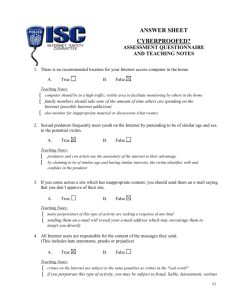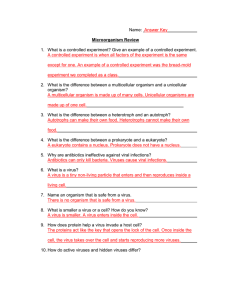Microbiology Study Guide
advertisement
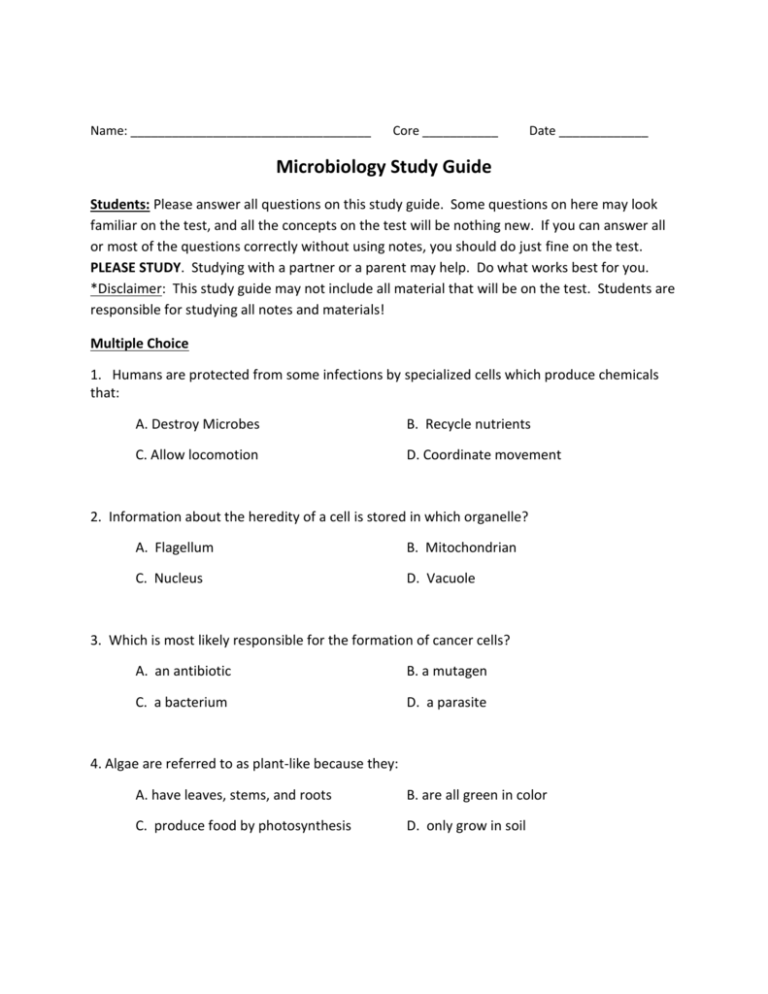
Name: ___________________________________ Core ___________ Date _____________ Microbiology Study Guide Students: Please answer all questions on this study guide. Some questions on here may look familiar on the test, and all the concepts on the test will be nothing new. If you can answer all or most of the questions correctly without using notes, you should do just fine on the test. PLEASE STUDY. Studying with a partner or a parent may help. Do what works best for you. *Disclaimer: This study guide may not include all material that will be on the test. Students are responsible for studying all notes and materials! Multiple Choice 1. Humans are protected from some infections by specialized cells which produce chemicals that: A. Destroy Microbes B. Recycle nutrients C. Allow locomotion D. Coordinate movement 2. Information about the heredity of a cell is stored in which organelle? A. Flagellum B. Mitochondrian C. Nucleus D. Vacuole 3. Which is most likely responsible for the formation of cancer cells? A. an antibiotic B. a mutagen C. a bacterium D. a parasite 4. Algae are referred to as plant-like because they: A. have leaves, stems, and roots B. are all green in color C. produce food by photosynthesis D. only grow in soil 5. Why do doctors suggest that people get a flu vaccine each year? A. Viruses replicate more rapidly B. Viruses can mutate from year to year. over time. C. Viruses are absorbed by the D. Vaccines get stronger over time. body after a year. 6. How is the cell membrane important to the process of osmosis? A. It allows water to move into the cell B. It allows all materials from the outside environment to move into the cell C. It traps water and nutrients that would otherwise be unable to move in the cell. D. It collects nutrients from water in the outside environment and moves them into the cell. 7. Cells can only come from: A. minerals B. water C. carbohydrates D. other cells 8. Both plants and animal cells contain: A. pseudopods B. cilia C. a nucleus D. chloroplasts 9. Malaria is a common disease in many countries. What is the cause of this disease? A. a virus B. a bacterium C. a fungus D. a parasite 10. How can the rate of an infectious disease be drastically reduced? A. By taking medication daily B. By preventing transmission between people C. By wearing clean clothing daily D. By performing dental hygiene three times each year. 11. What is the role of cytoplasm in a cell? A. fights infections B. digest proteins C. surround organelles D. pass on genetic information 12. Which of the following is NOT one of the main components of the cell theory? A. Cells are the basic unit of life B. Cells must contain DNA C. All living things are made of cells D. Cells can only come from other cells 13. A chemical that can kill bacteria without harming the human body is a(n) : A. Vaccine B. Water C. Antibiotic D. Virus 14. E. Coli is a type of bacteria that has leg-like or a whip-like structure called ________________, which is used to help propel the bacterium (movement). A. flagella B. spirillium C. bacillus D. cocci 15. Viruses can only reproduce by: A. finding another similar virus B. growing in a petri dish C. invading and taking over other cells. D. binary fission 16. Which of the following statements is TRUE? A. viruses are made of cells B. Viruses are treated with antibiotics C. viruses exhibit almost every D. Viruses are prevented with vaccinations characteristic of life 17. Bacteria are considered to be prokaryotic cells because: A. They have a nucleus B. they lack a nucleus C. They have many organelles that D. They have hereditary material perform many functions 18. Which is most likely the cause of the decline in measles cases from 1980 to 1990? A. antibiotics B. chemotherapy C. quarantines D. vaccinations 19. Which of the following is an autotroph? A. fungi B. Amoeba C. flower D. Goldfish 20. Which of the following is NOT used for movement (locomotion) for protists? A. flagellum B. cilia C. spirillium D. pseudopods 21. Which helps euglena respond to light? A. eyespot B. nucleus B. contractile vacuole D. flagellum 22. Animals or arthropods that carry a disease but may or may not have symptoms of the disease are called _________________. A. fungi B. vectors C. microbes D. basidium 23. Where would you find a paramecium? A. in quiet ponds B. in the human body C. in dirt D. on leaves 24. Which protists uses cilia for movement? A. volvox B. amoeba C. euglena D. paramecium 25. Ten people became sick with the flu after attending a school dance. What is the scenario that could best explain how the people got sick? A. contact with environmental sources B. contact with a contaminated object C. contact with an infected person D. contact with an infected animal 26. Malaria is a common disease in many countries. What is the cause of this disease? A. a virus B. a bacterium C. a fungus D. a parasite 27. How are parasites and viruses similar? A. Both are contagious diseases B. Both infect host organisms C. Both reproduce using host cells D. Both break down food using oxygen 28. What types of diseases would NOT be able to be spread by a mosquito? A. bacterial B. genetic C. protists D. viral 29. Which statement MOST closely describes how the polio vaccine works? A. It allows the blood to filter out the disease-causing agent B. It prevents the disease causing agent from entering the body C. It attacks the disease-causing agent as soon as it enters the body D. It triggers the immune system to produce antibodies to fight the disease. 30. What happens when an organism mutates? A. It becomes stronger B. it begins reproducing faster C. its genetic code changes D. spreads mutation to other members of the population
